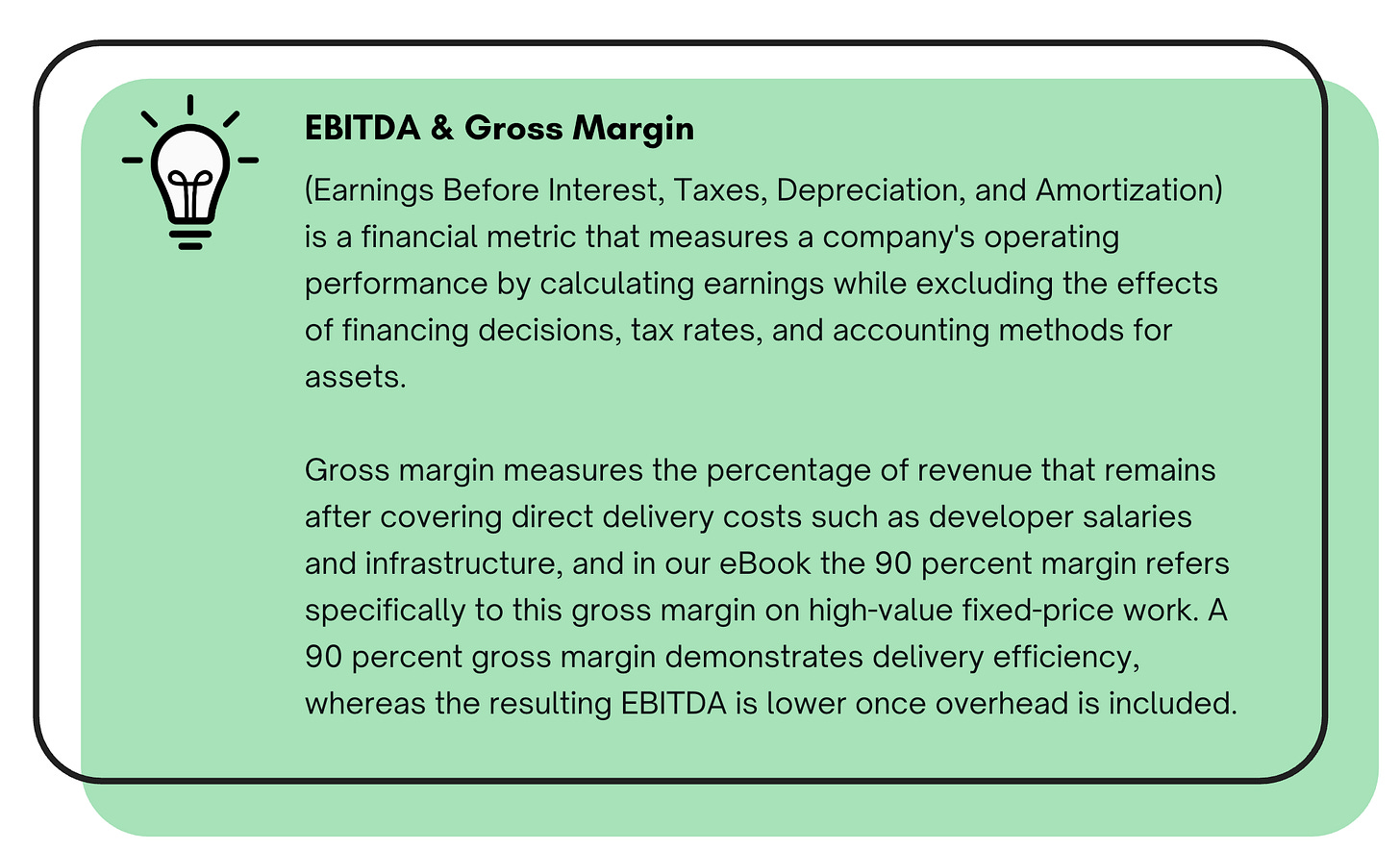How to Achieve 90% Margins: A Playbook for Software Houses
To achieve 90% margins, you don't need a new engine - you need a new mindset and a new set of plays.
Yeah, that was a nice opening, like yet another piece of coaching advice. However, this is a real story, and this playbook will give you actionable steps. You can check how Callstack grew with a staggering 30% EBITDA. You might think: How did they get there? Well, it isn't magic. It's math, mindset, and a repeatable process.
The numbers from BizRaport speak for themselves:
2023:
EBITDA: 41 657 294 PLN ÷ revenue 98 200 840 PLN ≈ 42.4 %
2024:
EBITDA: 47 375 337 PLN ÷ revenue 129 620 715 PLN ≈ 36.6 %
EBITDA (Earnings Before Interest, Taxes, Depreciation, and Amortization) measures your operating profitability by excluding financing costs and non-cash charges. To hit a 40% EBITDA, you must sustain exceptionally high operating margins that both cover all expenses and still leave ample room for that level of earnings.
These aren't just impressive figures - they represent a systematic approach to building a highly profitable software business. While many software houses struggle to break 20% margins, companies like Callstack have consistently delivered exceptional profitability while scaling their revenue. This playbook will show you how they and others have done it, and more importantly, how you can apply these same principles to your software business.
8 Common Reasons Why Software Houses Fail to Achieve High Margins
Before we unpack the specific plays, I noticed one eye-opening pattern in most software houses that reached out to me for consulting. Their hourly rates are surprisingly low, effectively cutting themselves off from high-margin opportunities.
Why does this happen? Here are the 8 biggest culprits:
Local market: They started from the local market and couldn't find a good reason to ask for a premium price. They're afraid that when they propose a higher rate, they hear, "Well, I can hire such a person instead."
Body leasing: Since they only offered remote developers hired through their agency, they could add a small margin on their rate; bigger ones were hard to justify.
Purposely competing on price: Fearing they'll lose on price, they start low with their prices and never get to the best deals.
Fear of losing a deal: They would rather win a low-margin project to keep his long-lasting employee in the company, but forget about the maintenance cost and their operations capacity that is spread too thin on low-margin & high-risk projects.
Fear of rising rates: Same as above, but this time avoiding rising rates, although everything rose and inflation ate a huge chunk of their margin already.
Walking dead: Running a software house on low margins usually leads to a walking dead mode. You wake up in the morning running for pennies, and you close your laptop with more troubles. This mode leads to a poor decision-making process and a search for “growth hacks/quick wins” which leads the Software House into a limbo of unfinished initiatives.
Big client: Having one big client blinded them. They eat their margin, and suddenly, find themselve in an unpleasant place - be acquire-hired or start actually selling their services to others?
Fixed-price projects. Tey began with fixed-price projects to secure the deal. Unfortunately, in many cases, they misestimate the required effort and apply only slim margins to the final price. Note: Selling fixed-price projects can be an ideal way to achieve up to 90% margins—I’ll show you how.
The above reasons are blinding the software house founders. They feel they live in a bubble they can't escape. They have no arguments to win this battle. It is sometimes just too hard to watch how they struggle every day.
Fortunately, many software companies have strong reasons to charge more. They deliver great value to their clients, but they overlook that.
The "Build to Sell" Lesson - Focus Over Breadth
A great book about it, "Build to Sell" describes such drama in an agency business.
At first, the author's agency offered half a dozen services, including web development, print collateral and marketing strategy, each delivered at only average quality. Margins were razor-thin, clients found it hard to understand the agency's core strength, and staff turnover rose. In a particularly painful debrief, a lost client said, “You do everything but nothing really well.”
That wake-up call revealed the problem: being a generalist diluted their value. He chose to specialize in logo design, created a clear delivery process and focused on a specific audience. Within months, the agency had transformed into a premium logo design boutique.
This book offers a valuable lesson for any software agency owner wrestling with the jack of all trades trap. Keep in mind, however, that while logo design can serve as an effective appetizer, it typically lacks the deal size necessary for a custom software house to sustain its growth. I think it's also an excellent read for anyone who struggles in their software agency.
Playbook: Plays to Reach 90% Margins
This isn't about bullshit coaching. It's about fundamentally rethinking your value and then structuring your sales, services, and client management around it.
Play #1: The 90% Margin Litmus Test Helps in Defining New High-Value Services
Ask yourself:
"Can I architect a deal structure for a specific type of project where a 90% margin is feasible?"
It is not about cheating your clients to pay more; it's about identifying scenarios where your unique value, efficiency, or the client's alternatives make such a margin justifiable because the value delivered is immense. If the immediate answer is "no way," your current mindset is the first bottleneck.
Keep reading with a 7-day free trial
Subscribe to Grow Your Software House to keep reading this post and get 7 days of free access to the full post archives.






